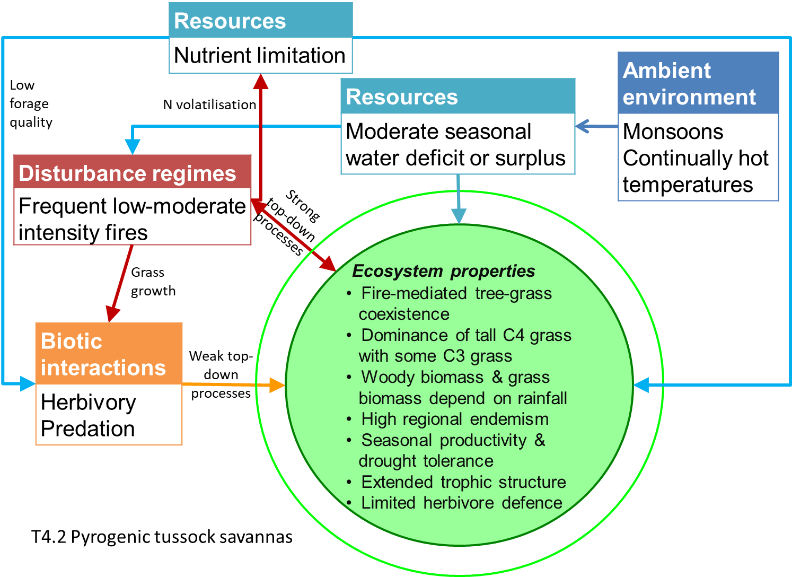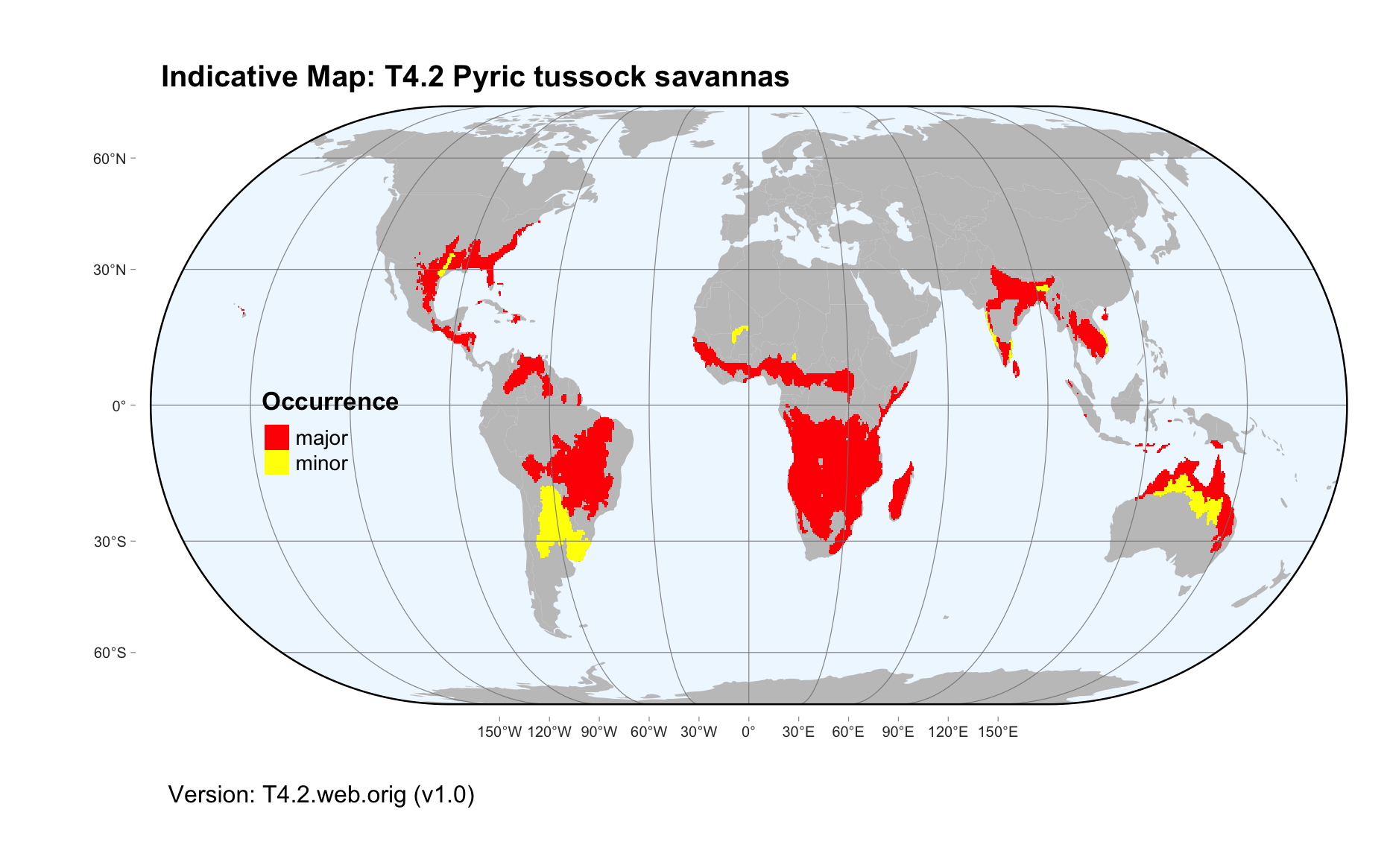Global ecosystem typology
Alternative site for the Global ecosystem typology with additional information for ecosystem profiles and indicative maps.
This site is maintained by jrfep
T4.2 Pyric tussock savannas
Biome: T4. Savannas and grasslands biome
Contributors:
(texts)
In pyric savannas, recurring fire is the principal agent that limits tree dominance and maintains tree-grass coexistence. Dominated by tussock grasses that grow tall during high-productivity wet summers and cure over dry winter seasons, these ecosystems occur on all major land masses at tropical and subtropical latitudes around the world. Large mammalian herbivores are usually present, but not at densities that limit grass growth or mediate tree-grass coexistence (unlike T4.1). Many plants have traits that promote tolerate of seasonal drought, such as deciduous leaf phenology, subterranean storage organs and deep roots. Invertebrate detritivores, notably termites, and vertebrate scavengers are key groups in the foodweb.
Key Features
Grasslands and grassy woodlands dominated by C4 tussock grasses. Strong seasonal (winter) drought, low fertility, and fires major consumer of biomass..
Overview of distribution
Global wet/dry tropics & subtropics.
Profile versions
- v1.0 (2020-01-20): CER Lehmann; A Etter; DA Keith
- v2.0 (2020-06-15): CER Lehmann; A Etter; KR Young; DA Keith
- v2.01 ():
- v2.1 (2022-04-06): CER Lehmann; A Etter; KR Young; DA Keith Full profile available at official site
Main references
Selected references for this functional group:
Lehmann CER, Anderson TM, Sankaran M, Higgins SI, Archibald S, Hoffmann WA, et al. (2014). Savanna vegetation-fire-climate relationships differ among continents. Science 343, 548-552.
Furley PA (1999) The nature and diversity of neotropical savanna vegetation with particular reference to the Brazilian cerrados Global Ecology and Biogeography 8, 223-241
Diagrammatic assembly model

Maps
Maps are indicative of global distribution patterns are not intended to represent fine-scale patterns. The maps show areas of the world containing major (coloured red) or minor occurrences (coloured yellow) of each ecosystem functional group. See general notes on maps.
There are 2 alternative versions of the indicative map for this functional group, please compare description and sources below.
T4.2.IM.orig_v1.0
Datasets
- Resolve-Ecoregions-2017
Map references
Dinerstein E, Olson D, Joshi A, Vynne C, Burgess ND, Wikramanayake E, Hahn N, Palminteri S, Hedao P, Noss R, Hansen M, Locke H, Ellis EE, Jones B, Barber CV, Hayes R, Kormos C, Martin V, Crist E, Sechrest W, Price L, Baillie JEM, Weeden D, Suckling K, Davis C, Sizer N, Moore R, Thau D, Birch T, Potapov P, Turubanova S, Tyukavina A, de Souza N, Pintea L, Brito JC, Llewellyn Barnekow Lillesø JP, van Breugel P, Graudal L, Voge M, Al-Shammari KF, Saleem M (2017) An Ecoregion-Based Approach to Protecting Half the Terrestrial Realm, BioScience 67: 534–545. DOI:10.1093/biosci/bix014. Data-set available on-line
T4.2.web.orig_v1.0

Datasets
- Resolve-Ecoregions-2017
Map references
Dinerstein E, Olson D, Joshi A, Vynne C, Burgess ND, Wikramanayake E, Hahn N, Palminteri S, Hedao P, Noss R, Hansen M, Locke H, Ellis EE, Jones B, Barber CV, Hayes R, Kormos C, Martin V, Crist E, Sechrest W, Price L, Baillie JEM, Weeden D, Suckling K, Davis C, Sizer N, Moore R, Thau D, Birch T, Potapov P, Turubanova S, Tyukavina A, de Souza N, Pintea L, Brito JC, Llewellyn Barnekow Lillesø JP, van Breugel P, Graudal L, Voge M, Al-Shammari KF, Saleem M (2017) An Ecoregion-Based Approach to Protecting Half the Terrestrial Realm, BioScience 67: 534–545. DOI:10.1093/biosci/bix014. Data-set available on-line
Check: the Glossary / Profile structure / the public document